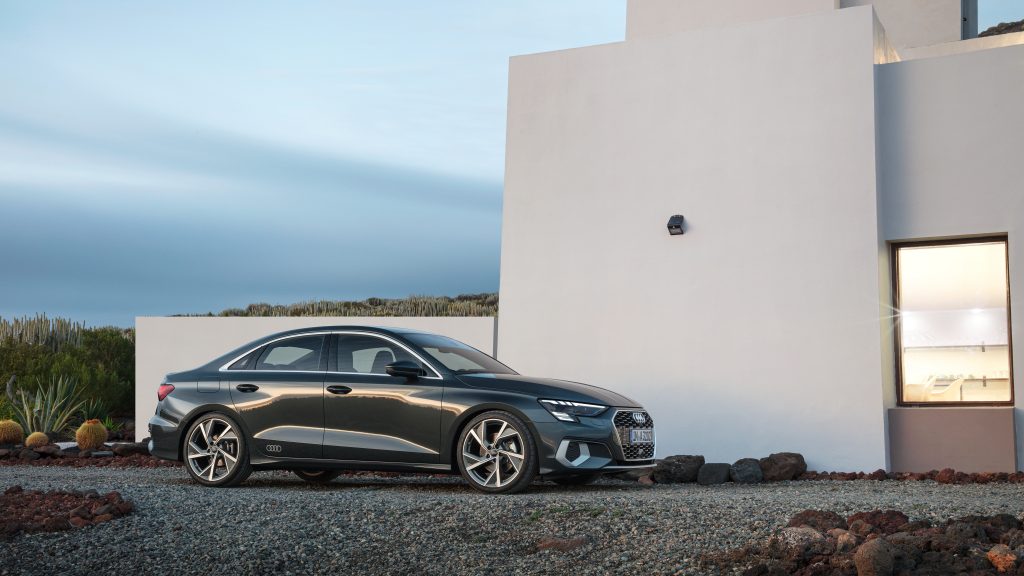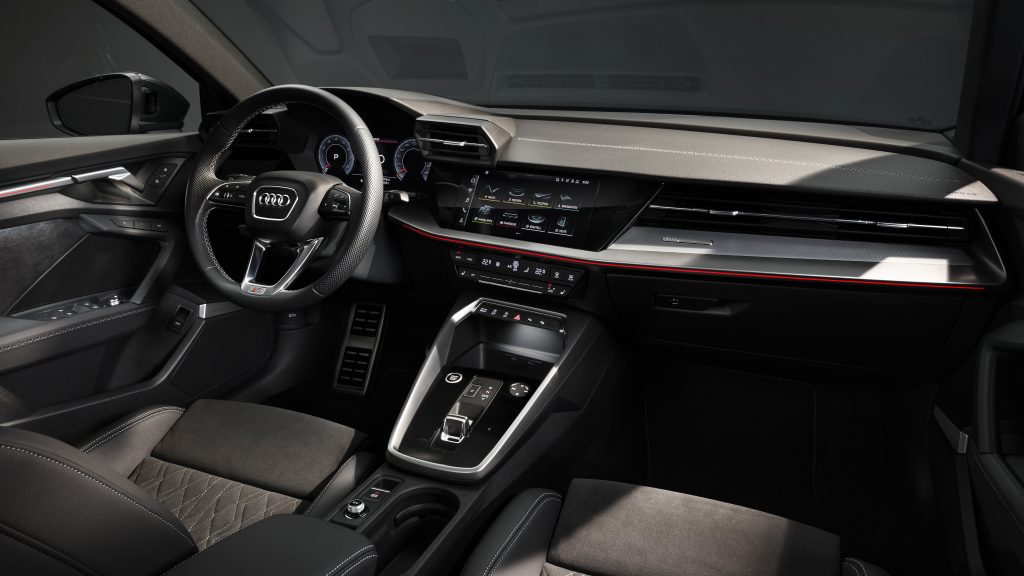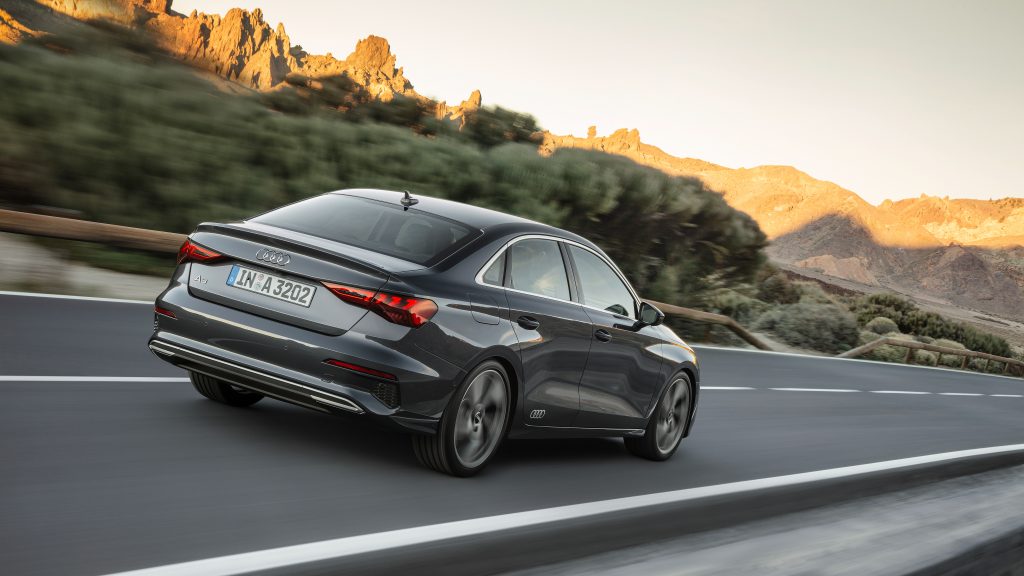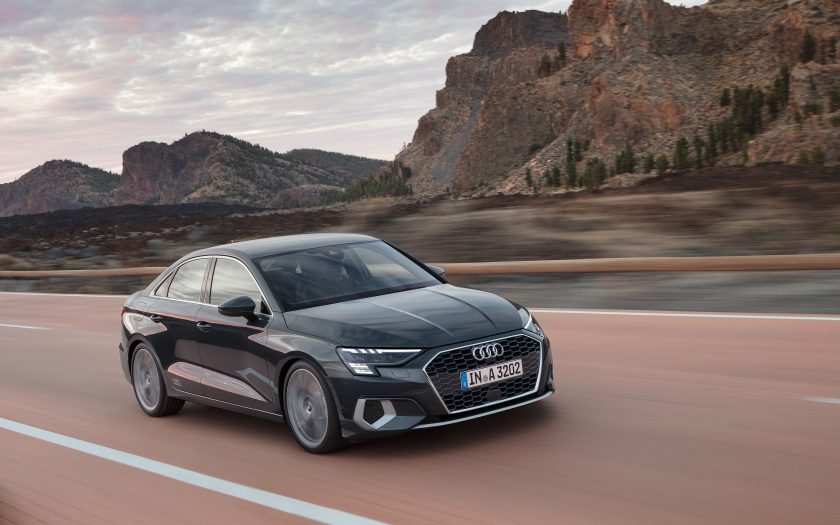EACH MODEL IN THE AUDI range seems to come in multiple variants. Latest to join the spread is the smart new A3 sedan, now with many of the advanced features recently announced in the larger A4.
The all-new A3 Sedan offers a sporty, elegant look. Compared with its predecessor, it is now four centimetres longer at 4.50 metres, while its wheelbase remains unchanged. Its width has increased by two centimetres to 1.82m and it is now one centimetre taller at 1.43m. This has yielded an increase in headroom – a good two centimetres in the front thanks to the lower position of the driver seat – and some more elbow room. At 425 litres, the luggage capacity is exactly the same as in the predecessor model.
Powerful and elegant
The front is dominated by a large Singleframe with honeycomb. The outside of the headlights form trapezoidal angles that are drawn downward. In the top model with Matrix LED technology, this is where the new digital daytime running lights are housed. They consist of a pixel array made up of 15 LED segments that can be actuated individually and give the various versions of the A3 Sedan a specific signature.
With the A3 Sportback, the body line running above the sill rises towards the rear lights before the rear wheel arch, thus accentuating the short rear end. The body line on the Sedan, by contrast, extends up to the rear bumper. This emphasizes its length – 15cm longer than the Sportback – and gives the flank an elegant appearance.
The concave surface under the broad body shoulder further accentuates the quattro blisters and the sill. This creates an intensive play of light and shadow. The roof line slopes down from the B-pillar dynamically – just like on a coupé – and finishes in a striking spoiler on the tailgate, optionally available in carbon.

Streamlined body
The aerodynamics benefit from the higher rear end compared with the predecessor as well as the large diffuser. As a result, the all-new A3 Sedan with the 2.0 TDI 110 kW achieves a Cd value of 0.25, 0.04 Cd points better than the first generation. The controllable cooling-air inlet with two electrically actuated louvre modules behind the grille also contribute to this. They regulate the flow of air intelligently and according to the situation. In addition, the panelled underbody, the exterior mirrors with improved aerodynamics, and the active brake cooling reduce air resistance contribute to the low Cd.
Focused and digitalized: the cockpit
The cockpit of the A3 Sedan is entirely focused on the driver. This begins with the interior design and ends with the display and control elements. The instrument panel with a 10.1-inch central MMI touch display is inclined slightly toward the driver. As standard, it includes handwriting detection as well as natural language control that can optionally draw on the capabilities of the cloud. The 10.25-inch instrument cluster behind the steering wheel is digital even in the basic model. As the Audi virtual cockpit plus, it measures 12.3-inches and offers three different views, including sporty graphics with inclined digits and a particularly dynamic layout. The RPM and speed are shown here as bar diagrams with angular red graphical elements. Upon request, a head-up display complements the display concept, projecting important information onto the windshield in the driver’s direct field of vision.

Highly connected: from infotainment to driver assistance
The top infotainment system in the all-new A3 Sedan is the MMI Navigation plus, which uses the third-generation modular infotainment platform (MIB 3). The MIB 3 boasts computing power ten times higher than in the predecessor model, connects the car via LTE Advanced speed, and connects the smartphones of the passengers to the Internet via Wi-Fi hotspot. The MMI Navigation plus offers a multitude of Audi connect services as standard, including online traffic information, news, and additional information such as photos, opening times, and user reviews relating to points of interest.
Car-to-X services that make use of the swarm intelligence of the Audi fleet are also part of the portfolio. They report hazardous areas or speed limits, for example, to vehicles with the corresponding equipment or find free parking spaces at the side of the road. If the car is switched off, the myAudi app continues navigation from the car on a smartphone. This way, customers reaches their destination directly.
The A3 Sedan is also connected to the smartphone via the Audi smartphone interface, which integrates iOS and Android cell phones with Apple Car Play and Android Auto in the MMI, as well as via Audi phone box. The latter connects the device to the car antenna and can charge it inductively. Continuing the high-tech story, the A3 Sedan can be locked and unlocked as well as started via an Android smartphone with the Audi connect key. Personalization allows up to six users to store their preferred settings in individual profiles, including those for the seat, climate control and media. The digital radio comes as standard. Options include online radio and the hybrid radio, which automatically switches between FM, DAB, and the online stream depending on a station’s signal strength, thus ensuring optimum reception.
The driver assist systems are also particularly effective thanks to the close networking. In the Audi pre sense front system, the camera behind the interior mirror works together with the front radar to prevent accidents, or at least reduce their severity. The standard collision avoidance assist also uses the data from this sensor system. Adaptive cruise assist, an innovation from the full-size class, supports drivers with longitudinal and lateral guidance. The efficiency assist notifies them when it would be sensible to take their foot off the accelerator. To do so, it evaluates information including the navigation data. The exit warning, the cross-traffic assist and the surround view cameras that will follow shortly after the market launch are also useful in in urban traffic.

Three engines at launch
The all-new A3 Sedan is available with a choice of two TFSI engines and one TDI engine at launch. The 35 TFSI, a 1.5-litre direct injection engine, produces 110 kW and is available in two versions – with a newly developed six-speed manual transmission (combined fuel consumption: 5.0 – 4.7L/100km; combined CO2 emissions: 114 – 108g/km) and with a quick-shifting seven-speed S tronic (combined fuel consumption: 4.9 – 4.7L/100km; combined CO2 emissions: 113 – 107g/km).
Besides the cylinder on demand technology, the powertrain in conjunction with the S tronic dual-clutch transmission uses a 48-volt mild hybrid system. It recovers energy during deceleration, supports the engine with up to 50Nm of torque when driving off and accelerating from low engine speeds and allows the A3 Sedan to coast with the engine switched off in many situations. In everyday driving, it reduces consumption by up to 0.4L/100km.
The 2.0 TDI with 110 kW (combined fuel consumption: 3.9 – 3.6L/100km; combined CO2 emissions: 101 – 96g/km) also works in conjunction with a seven-speed S tronic, with gear shifts performed via a new switch using shift-by-wire technology.
Comfortable and dynamic
The suspension of the all-new A3 Sedan has been tuned to be a touch more precise than in the previous model. To a large degree, this precision and reaction speed is thanks to the central dynamic handling system that ensures optimal interaction between all the components relevant to the transverse dynamics. As an alternative to the standard setup, there is a sport suspension and a suspension with controlled dampers. The latter offers a wide spread between highly comfortable roll motion and agile handling. The Audi drive select dynamic handling system also allows the driver to experience different levels of suspension tuning – from comfort-oriented and distinctly dynamic right through to particularly fuel-efficient. This also brings about changes in the characteristics of the throttle response and the progressive steering, for example, which varies its ratio depending on the steering angle.
Australian information
The all-new Audi A3 Sedan is expected to arrive in Australia in the first half of 2021. Further details on specific models, pricing and specification will be announced closer to launch.
